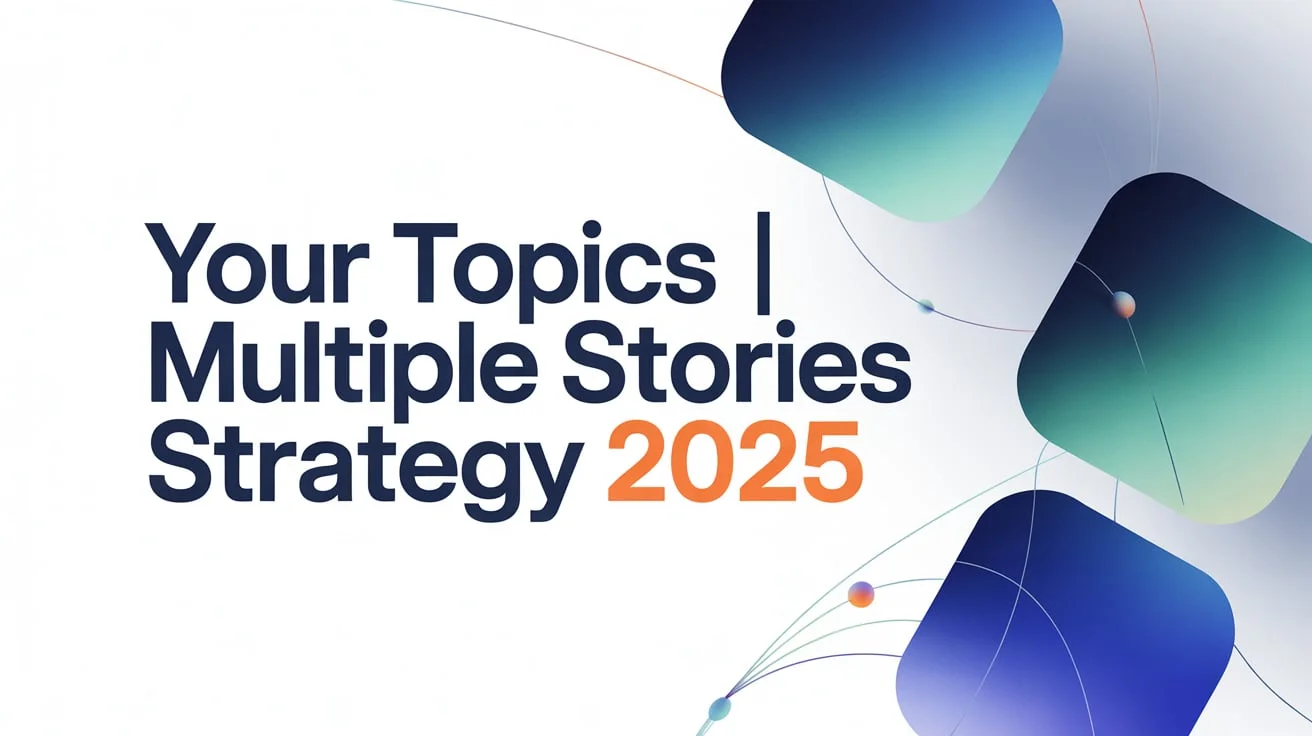In a world awash with content, brands that double down on one single narrative risk fading into the noise. In 2025, your audience expects nuance, layers, and authenticity. That’s where a multiple stories strategy wins: telling interconnected but distinct stories across different channels to reach more people, deepen trust, and spark action.
This post unpacks how to design, launch, measure, and refine a multiple stories strategy in 2025. You’ll get concrete frameworks, real-life case studies, metrics to watch, and pitfalls to avoid.
Imagine you’re reading a novel with multiple threads—some about characters’ pasts, others about conflicts in the present, and still others pointing toward the future. That’s exactly what a multiple stories strategy does in brand storytelling: you run parallel narrative strands that complement one another.
In 2025, a single linear message is too flat. Audiences are segmented by interest, channel, generation, and attention span. To truly connect, you need different lenses on your core mission.
By the end of this article, you’ll know how to:
- Identify and structure multiple narrative streams
- Map each story to audience segments and channels
- Build a workflow and editorial engine to sustain it
- Measure impact, iterate, and scale
- Avoid the common traps that kill narrative coherence
Let’s dive in.
Why Multiple Stories Matter in 2025
Fragmented Audiences, Diverse Values
Your customers no longer share a monolithic worldview. The audience that follows you on Instagram may differ in values and expectations from the one on LinkedIn or in your email list. One story won’t resonate with all.
Platform Multiplicity
In 2025, people move across platforms: podcasts, micro-video, newsletters, long-form articles, social media, and increasingly the “quiet” channels (newsletters, private communities). You need narrative threads that fit each format.
Trust & Authenticity Require Nuance
Monolithic stories often feel authoritarian or hollow. But layered, honest stories—where you reveal weaknesses, behind-the-scenes, aspirations, and failures—feel human and credible.
Competitive Differentiation
Brands that do this well stand out. Pulse Advertising argues that “multi-part content strategy rules social media” now. One-off viral hits aren’t enough anymore.
Kantar’s 2025 marketing trends also push this: the call for total video and distinctiveness across formats demands narrative agility.
Core Principles of a Multiple Stories Strategy
To get multiple stories right, you need guardrails. These five principles keep your narratives cohesive and powerful.
| Principle | What It Means | Why It Matters |
| Aligned but distinct | Each story centers on a different angle but ties back to your core mission | Prevents fragmentation and ensures brand coherence |
| Modular storytelling units | You build small “story blocks”—themes, people, timelines—that can shift and reassemble | Easier to repackage, adapt, and cross-reference |
| Narrative pacing & cadence | You control when to emphasize which story, when to pause or merge strands | Prevents audience fatigue and keeps momentum |
| Feedback loops & iteration | You listen to responses and adapt in real time | Keeps you relevant and responsive |
| Consistency with flexibility | You maintain brand tone, core values, voice, even if the stories vary in style | Avoids confusion or contradiction |
Aligned but distinct
Think of your brand as a tree. The trunk is your mission. The branches are the individual stories. Each branch must lead back to the trunk—even if it stretches outward.
Modular units
For instance, you might have “customer journey,” “product innovation,” and “future vision” as modules. Each of those becomes a reusable unit across formats.
Narrative pacing & cadence
You don’t run all stories at full tilt at once. You rotate emphasis, giving breathing space and layering anticipation.
Feedback loops & iteration
Track which narratives resonate, which fall flat, then shift resource accordingly. Storytelling doesn’t happen in a vacuum.
Consistency with flexibility
You keep your brand “voice,” but allow style shifts (e.g. behind-the-scenes might be candid and informal; vision stories more elevated).
Types of Stories You Can Run in Parallel
Here are six core narrative streams you can weave concurrently:
- Origin / founding story
- Customer / user stories
- Process / behind-the-scenes stories
- Vision / future stories
- Challenge / failure / pivot stories
- Culture / values stories
Let’s break each down with examples and guidance.
Origin / Founding Story
This is your “why we began” story. It anchors trust and frames purpose. Use it sparingly—people don’t need to hear it every month.
Example: A startup might tell how it began in a cramped garage, overcoming resource constraints. That narrative anchors future stories.
Customer / User Stories
This is often the most potent. Let customers speak. Show how your solution changed lives.
Example: Airbnb’s Host Stories highlights hosts and their lives, making the platform feel human.
Process / Behind-the-Scenes
Show how your product gets made, what trade-offs you face, or internal debates. People crave insight.
Example: Rare Beauty’s newsletter uses behind-the-scenes content—development stories, team struggles, personal perspectives.
Vision / Future Stories
Where are you going? What new horizons do you aim to reach? This draws fans into your journey.
Challenge / Failure / Pivot Stories
Don’t hide stumbles. Share what you tried, dropped, or changed. Audiences love vulnerability.
Culture / Values Stories
Show your team rituals, beliefs, internal norms. The more you humanize, the more connection.
Across all these, you can mix and match for depth.
Mapping Stories to Audiences & Channels
For maximum impact, you must map stories to personas and formats.
Audience segmentation
List your key audience groups—e.g. early adopters, power users, skeptics, referrers. For each, ask: what story resonates most?
Story → Channel fit
| Story Type | Best Formats / Channels | Usage Tips |
| Origin / Founding | Long-form blog, podcast, about page | Reserve for deeper content |
| User story | Short video, testimonial, social post | Use raw voice, minimal polishing |
| Behind-the-scenes | Stories, Reels, newsletter | Casual tone works well |
| Vision | Keynote, long-form article, video | Elevated, aspirational |
| Failure / pivot | Blog posts, podcast | Be honest, show learning |
| Culture / values | TikTok, office clips, social | Humanize, not polish too much |
Example mapping
- Persona A (innovator) cares about vision + process stories
- Persona B (pragmatist) cares about customer stories + challenge stories
- Persona C (community/believer) cares about culture + values stories
This ensures you reach each persona via stories they’ll care about.
Workflow & Editorial Planning
Executing multiple narrative streams requires structure.
Story backlog & pipeline
Keep a running backlog of story ideas. Tag each idea with:
- Narrative stream (origin, user, vision, etc.)
- Status (idea, draft, in review, queued, published)
- Estimated timing
Story templates / skeletons
Create skeletons you can reuse. Each narrative type can have a pattern: hook → conflict → resolution → lesson. Fill that in per story.
Publishing calendar & overlapping campaigns
Your editorial calendar should layer at least 2–3 story arcs simultaneously. Use overlapping campaigns to create synergy.
Cross-referencing stories
Link stories to each other—“Remember when we talked about X, now here’s how it evolved in Y.” Drop Easter eggs. Build a “story web.”
Roles & responsibilities
Define who does what:
- Idea generation
- Writing / scripting
- Editing
- Multimedia production
- Publishing & distribution
- Analytics & iteration
Make sure people aren’t overlapping or dropping handoffs.
Measurement & KPIs
You can’t shoot in the dark. You need metrics tied back to narrative performance.
Story-level metrics
- Reach & Impressions per story
- Engagement: likes, comments, shares
- Time spent / scroll depth
- Clicks / CTAs within each narrative
Conversion & attribution
- Which story aided a signup, purchase, or form fill?
- Use multi-touch attribution: assign weight to stories in the path.
Cross-story lift
Does one story boost the reach or engagement of another when referenced or linked? Track lift effects.
Qualitative signals
- Feedback in comments
- Direct messages or emails referencing a story
- Survey responses on which story resonated
Aim to capture both quantitative and qualitative.
Optimization & Iteration
Your strategy should evolve, not stagnate.
A/B test narrative hooks
Test derivatives: same story, different opener or headline. See which hook pulls stronger engagement.
Listening & feedback tools
Use social listening, comment threads, poll features, and surveys to gauge sentiment and resonance.
Prune & double down
If a narrative stream underperforms persistently, sunset it. Double down on what works.
Refreshing narratives
Every 6–12 months revisit your stories to update, reframe, or spin off subplots.
Scaling
As you expand, you can add mini-stories or subplots. For instance: a “mini-series” inside a user story.
Read More: Pedrovazpaulo Real Estate Investment: Strategies, Insights & Future Vision
Case Studies & Examples (2025 Edition)
These brands use multiple narratives, not just one, and they do it well.
Case Study: Rare Beauty & Substack as Narrative Hub
Rare Beauty uses Instagram and TikTok, but lean heavily on a newsletter called Rare Beauty Secrets (on Substack). That newsletter acts as a narrative hub where they share behind-the-scenes development, founder reflections, mental health stories, and community voices. It deepens narrative control beyond algorithmic platforms.
Case Study: Travel Oregon’s Integrated Storytelling
Travel Oregon blends destination stories, community hero narratives, cultural stories, and environmental values. Their content strategy earned them the Content Marketing Institute’s 2024 “Content Strategy of the Year” award.
Case Study: Rhino & “A Ball for the Planet”
Rhino launched “A Ball for the Planet,” a narrative combining sustainability, community, and sports. They show ball production, communities impacted, and environmental metrics. It’s a multi-strand approach: product story + values story + impact story.
Case Study: Merit Beauty’s Slow, Multi-Narrative Approach
Merit has resisted chasing virality. Instead, they commit to slow, emotionally driven brand storytelling. Their marketing, product, and creative teams align narratives across platforms. As of 2025, the brand has generated over $100 million in revenue, rooted in narrative discipline.
Common Pitfalls & How to Avoid Them
You can stumble in this strategy. Here are five traps and how to dodge them.
Story fragmentation
If stories don’t tie back to your core mission, your brand feels scattered. Always connect back to your central narrative thread.
Over-promising
A vision story that promises more than delivery can backfire. Ensure your stories are grounded.
Narrative inconsistency
If your values story contradicts your culture story or your public actions, audiences will call you out.
Under-resourcing
Running multiple narratives is work. Don’t promise what you can’t sustain.
Ignoring feedback
If you refuse to adapt, the audience will drift away. Listen, adjust, repeat.
Roadmap to Launch Your Strategy in 2025
Here’s your step-by-step guide:
- Audit your current narratives
List existing stories, see gaps, note what’s working. - Select 2–4 core narrative streams
Don’t overextend. Start with a few. - Build your first 6-month content calendar
Slot stories, vary formats, plan overlaps. - Set target KPIs
Story engagement, attribution, qualitative feedback. - Launch & publish incrementally
Monitor what works. - Iterate & scale
Expand successful strands, prune weak ones.
Conclusion
A multiple stories strategy 2025 is your way to stay alive in a noisy media world. It lets you reach different audiences, deepen trust, and layer meaning across platforms.
Start small. Build modular story units. Lead with feedback. Over time, your brand will evolve into a narrative ecosystem people don’t just read—they live with.
Your next step: pick two narrative streams you haven’t fully explored yet (e.g. failure stories, customer journey), and sketch one content piece around each. Try, test, and iterate.
Let me know if you want me to turn any section into a downloadable template or full draft

Meet Mia Rose, the heart and hands behind the whimsical wonders at PunnyPeeks. With a keen eye for detail and a passion for creative expression, Mia turns balloons into art and events into unforgettable experiences. Whether she’s styling a dreamy wedding arch or adding a playful pop to a birthday party, her work radiates joy, color, and personality.




